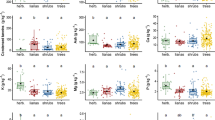Abstract
Twenty weeks forage re-growth from 20 multipurpose trees and shrubs (MPTS) species (Albizia ferruginea, Albizia gummifera, Albizia niopoides, Berlinia grandiflora, Bauhimia monandra, Dialium guineense, Dalbergia sissoo, Enterolobium cyclocarpum, Leucaena leucocephala, Lonchocarpus sericeus, Milletia griffoneanus, Milletia thoningii, Napoliana imperialis, Parkia bicolor, Pterocarpus santalinoides, Senna spectabilis, Treculia africana, Terminalia superba, Tetrapluera tetraptera and Xylia xylocarpa) were investigated for their feed value. The MPTS were grown on an ultisol in southeastern Nigeria and were subjected to proximate analyses, nylon bag degradability studies and cluster analysis. Among species, crude protein (CP) ranged from 104 g kg−1 DM in P. bicolor to 205 g kg−1 DM in A. gummifera, neutral detergent fibre (NDF) ranged from 498 g kg−1 DM in L. leucocephala to 771 g kg−1 DM in L. sericeus, acid detergent fibre (ADF) ranged from 303 g kg−1 DM in T. superba to 661 g kg−1 DM in L. sericeus, acid detergent lignin (ADL) ranged from 75 g kg−1 DM in T. superba to 305 g kg−1 DM in L. sericeus. Also, ADF-ash ranged from 0.78 g kg−1 DM in E. cyclocarpum to 15.58 g kg−1 DM in D. guineense. Except E. cyclocarpum and S. spectabilis, the remaining 18 MPTS studied had effective degradabilities (ED) less than 500 g kg−1 DM effective degradability. Eight MPTS (A. ferruginea, A. niopoides, B. monandra, D. sissoo, E. cyclocarpum, L. leucocephala, S. spectabilis, T. superba) were classified as high quality, another eight (A. gummifera, B. grandiflora, L. sericeus, N. imperialis, P. bicolor, P. santalinoides, T. tetraptera and X. xylocarpa) as medium quality while, the remaining four (D. guineensis, M. griffoneanus, M. thoningii, T. africana) fell into the low quality class based on their nutrient composition and ruminal DM degradability. The results indicate that most of the MPTS could be used as good quality feed for small ruminants in Nigeria.



Similar content being viewed by others
References
AFNETA (1991) Alley Farming Network for Tropical Africa. Annual Technical Report. International Institute of Tropical Agriculture (IITA) Ibadan, Nigeria, 99 pp
AOAC (Association of Official Analytical Chemists) (2002) Official methods of analysis of AOAC International, 17th ed. AOAC International. Gaithersburg, MD, USA (AOAC Official Methods 954.01
Cheng K-J, Stewart CS, Dinsdale D, Costerlon JW (1984) Electron microscopy of bacteria involved in the digestion of plant cell walls. Anim Feed Sci Technol 10:93–120
Devendra C, Sevilla CC (2002) Availability and use of feed resources in crop-animal systems in Asia. Agric Syst 71:59–73
Kang BT, Reynolds L, Atta-Krah AN (1990) Alley farming. Adv Agron 43:315–319
Larbi A, Jabber MA, Orok NB, Idiong B, Cobbina J (1993) Alchornea cordifolia: a promising indigenous browse species adapted to acid soils in south eastern Nigeria for integrated crop-livestock agroforestry production system. Agrofor Syst 22:33–41
Larbi A, Smith JW, Raji AM, Kurdi IO, Adekunle IO, Ladipo DO (1997) Seasonal dynamics in dry matter degradation of browse in cattle, sheep and goats. Small Rumin Res 25:129–140
Larbi A, Smith JW, Kurdi IO, Adekunle IO, Ladipo DO (1998) Chemical composition, rumen degradation and gas production characteristics of some multi-purpose trees and shrubs during wet and dry seasons in the humid tropics. Anim Feed Sci Technol 72:81–96
Larbi A, Awojide AA, Adekunle IO, Ladipo DO, Akinlade JA (2000) Fodder production responses to pruning height and fodder quality of some trees and shrubs in a forest savanna transition zone of south western Nigeria. Agrofor Syst 48:157–168
Larbi A, Anyanwu NJ, Oji UI, Etela I, Gbaraneh LD, Ladipo DO (2005) Fodder yield and nutritive value of browse species in the West African humid tropics: response to age of coppice regrowth. Agrofor Syst 65:197–205
Le Houerou HN (1980) Chemical composition and nutritive value of browse in tropical West Africa. In: Le Houerou HN (ed) Browse in Africa: the current state of Knowledge. International Livestock Centre for Africa (ILCA) Addis Ababa, Ethiopia, pp 261–279
McDonald I (1981) A revised model for the estimation of protein degradability in the rumen. J Agric Sci Camb 96:251–252
Norton BW (1994) Nutritive value of tree legumes. In: Gutteridge RC, Shelton HM (eds) Forage tree legumes in tropical agriculture. CAB International, Oxon
Nsahlai IV, Siaw DEK, Osuji PO (1994) The relationships between gas production characteristics and chemical composition of 23 browses of the genus Sesbania. J Sci Food Agric 65:13–20
Ørskov ER, McDonald I (1979) The estimation of protein degradability in the rumen from incubation measurements weighted according to rates of passage. J Agric Sci Camb 92:499–503
SAS (2002) SAS for Windows Release 9.1. Statistical Analysis Systems Institute Inc.: Cary, NC, USA
Van Soest PJ, Robertson JB, Lewis BA (1991) Methods for dietary fibre, neutral detergent fibre and nonstarch polysaccharides in relation to animal nutrition. J Dairy Sci 74:3583–3597
Acknowledgments
Staff and management of the International Institute of Tropical Agriculture (IITA) and International Livestock Research Institute (ILRI), Ibadan are acknowledged for data collection and provision of facilities for the project.
Author information
Authors and Affiliations
Corresponding author
Rights and permissions
About this article
Cite this article
Anyanwu, N.J., Etela, I. Chemical composition and dry matter degradation characteristics of multi-purpose trees and shrubs in the humid lowlands of southeastern Nigeria. Agroforest Syst 87, 747–754 (2013). https://doi.org/10.1007/s10457-012-9593-6
Received:
Accepted:
Published:
Issue Date:
DOI: https://doi.org/10.1007/s10457-012-9593-6




